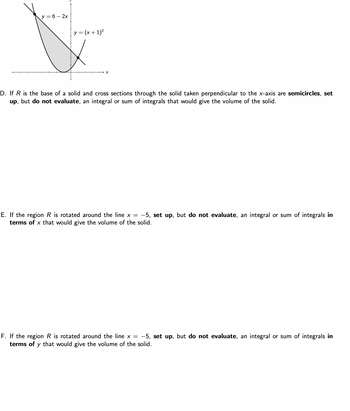Let R be the region given by the graph below. y = 6 - 2x y = (x + 1)² X A. Calculate the intersection points (x, y) of the two curves shown in the graph above. Remember to show your work. B. Set up, but do not evaluate, an integral or sum of integrals in terms of x that would give the area of the shaded region. C. Set up, but do not evaluate, an integral or sum of integrals in terms of y that would give the area of the shaded region.
Let R be the region given by the graph below. y = 6 - 2x y = (x + 1)² X A. Calculate the intersection points (x, y) of the two curves shown in the graph above. Remember to show your work. B. Set up, but do not evaluate, an integral or sum of integrals in terms of x that would give the area of the shaded region. C. Set up, but do not evaluate, an integral or sum of integrals in terms of y that would give the area of the shaded region.
Calculus: Early Transcendentals
8th Edition
ISBN:9781285741550
Author:James Stewart
Publisher:James Stewart
Chapter1: Functions And Models
Section: Chapter Questions
Problem 1RCC: (a) What is a function? What are its domain and range? (b) What is the graph of a function? (c) How...
Related questions
Question
Please show all work, thank you

Transcribed Image Text:Let R be the region given by the graph below.
y = 6 - 2x
y = (x + 1)²
A. Calculate the intersection points (x, y) of the two curves shown in the graph above. Remember to show your work.
B. Set up, but do not evaluate, an integral or sum of integrals in terms of x that would give the area of the shaded
region.
C. Set up, but do not evaluate, an integral or sum of integrals in terms of y that would give the area of the shaded
region.
Expert Solution
This question has been solved!
Explore an expertly crafted, step-by-step solution for a thorough understanding of key concepts.
This is a popular solution!
Trending now
This is a popular solution!
Step by step
Solved in 3 steps with 3 images

Follow-up Questions
Read through expert solutions to related follow-up questions below.
Follow-up Question
Please show all work thanks

Transcribed Image Text:y = 6 - 2x
y = (x + 1)²
D. If R is the base of a solid and cross sections through the solid taken perpendicular to the x-axis are semicircles, set
up, but do not evaluate, an integral or sum of integrals that would give the volume of the solid.
E. If the region R is rotated around the line x = -5, set up, but do not evaluate, an integral or sum of integrals in
terms of x that would give the volume of the solid.
F. If the region R is rotated around the line x = -5, set up, but do not evaluate, an integral or sum of integrals in
terms of y that would give the volume of the solid.
Solution
Recommended textbooks for you

Calculus: Early Transcendentals
Calculus
ISBN:
9781285741550
Author:
James Stewart
Publisher:
Cengage Learning

Thomas' Calculus (14th Edition)
Calculus
ISBN:
9780134438986
Author:
Joel R. Hass, Christopher E. Heil, Maurice D. Weir
Publisher:
PEARSON

Calculus: Early Transcendentals (3rd Edition)
Calculus
ISBN:
9780134763644
Author:
William L. Briggs, Lyle Cochran, Bernard Gillett, Eric Schulz
Publisher:
PEARSON

Calculus: Early Transcendentals
Calculus
ISBN:
9781285741550
Author:
James Stewart
Publisher:
Cengage Learning

Thomas' Calculus (14th Edition)
Calculus
ISBN:
9780134438986
Author:
Joel R. Hass, Christopher E. Heil, Maurice D. Weir
Publisher:
PEARSON

Calculus: Early Transcendentals (3rd Edition)
Calculus
ISBN:
9780134763644
Author:
William L. Briggs, Lyle Cochran, Bernard Gillett, Eric Schulz
Publisher:
PEARSON

Calculus: Early Transcendentals
Calculus
ISBN:
9781319050740
Author:
Jon Rogawski, Colin Adams, Robert Franzosa
Publisher:
W. H. Freeman


Calculus: Early Transcendental Functions
Calculus
ISBN:
9781337552516
Author:
Ron Larson, Bruce H. Edwards
Publisher:
Cengage Learning